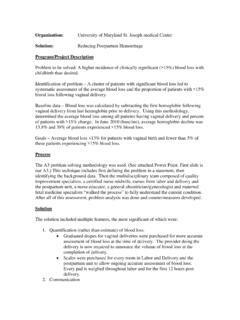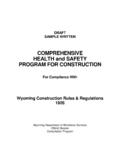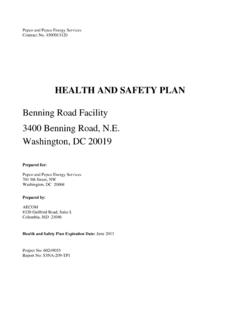Transcription of Discharge Planning and Preparation on the Behavioral ...
1 Discharge Planning and Preparation on the Behavioral health Unit - Recovery action plan : We RAP! Program Description The Behavioral health Unit (BHU) at Harford Memorial Hospital (HMH) is the primary mental health care provider in Harford and Western Cecil Counties. The focus of the BHU is to address the patient in crisis, assist with treatment and stabilization, and promote the safe return of the patient to the community utilizing the patient-centered care approach that is an integral part of the mission and vision of Upper Chesapeake health . The unit is comprised of 27 beds, male/. female, and ages 18 and older. Both voluntary and involuntary admissions are accepted. Mental health treatment is delivered utilizing a multi-disciplinary approach which includes Nurses, Psychiatrists, Social Workers, Occupational Therapists, Case Managers, and Patient Care Technicians. Other disciplines, such as Dieticians, Respiratory, Speech and Physical Therapists are included on the Treatment Team as needed based on the patient's unique needs.
2 Outpatient resources offered at HMH include an Intensive Outpatient Program and traditional Outpatient Clinic Services. This promotes a comprehensive service line of After Care available for patients, not only for those discharged from the BHU, but also for the community at large. As the primary mental health service provider we saw a large number of patients with chronic mental health issues who want to be treated close to home. Our challenge was to meet those needs of our patients and better equip them to remain in the community and access outpatient services. We determined that reducing hospital readmissions would be the best measure of success. Process A literature search identified that Nurses, Social Workers and Discharge Planners have been implementing new and innovative approaches to decrease readmissions. One of those approaches was the WRAP program created by Mary Ellen Copeland, PhD.
3 Nurses from the BHU attended the WRAP Around the World Conference presented by the Copeland Center for Wellness and Recovery in Philadelphia in August of 2011. The concept of aggressive Discharge Planning utilizing the Wellness Recovery action plan concept ignited the creative juices of the nurses. Using this evidenced-based concept, a Multidisciplinary team began creating a plan that would work to capture the configuration of the BHU patient population including diagnosis, age range, intellectual functioning and the general condition of the unit milieu. The RAP Recovery action plan was developed and implemented in November of 2011. Solution This Wellness Tool Kit places the emphasis on recovery of illness and Preparation for Discharge . The Tool Kit consists of educational resources including post Discharge Daily Schedule of Activity and Medication, personalized Crisis plan and Aftercare plan .
4 The components include follow-up appointments for Mental health and somatic treatment, Support Groups, phone numbers to use in event of crisis, and of names of Mental health professionals, and other support systems available for the patient. Upon admission, as appropriate, every patient receives a RAP folder. The folder has a RAP label on the outer cover with a place to record emergency numbers such as the Mobile Crisis Team, and the outpatient Psychiatrist's name. Patients are instructed to attend scheduled RAP Groups and to bring their folder. RAP Group is conducted at least three times weekly. Since the average length of stay is 3-5 days, the majority of patients will attend a RAP Group during their hospitalization. It is open to all patients and all patients are encouraged to attend. The patient opens the Tool Kit with instruction and completes the directed component for that session.
5 The 5 Key Recovery Concepts are reviewed: Hope, Personal Responsibility, Self- Advocacy, Education, and Support. Wellness tools (coping skills) are identified by each patient and recorded. A schedule for each day of the week is completed, anticipating needs upon Discharge . Activities such as self-care, appointments, and a medication schedule are incorporated. Also, additional activities to promote daily structure are explored. This detailed plan consists of Emergency Contacts, Emergent health Needs, Service Providers involved, transportation issues and cultural/spirituality needs. Patients identify: who to notify in event of a crisis, how to manage symptom emergence, issues with medications, concerns with transportation to after care appointments, and even financial barriers. Patients have the opportunity to share resources and suggestions for success with peers. The Group is an interactive process, promoting peer interaction and independence.
6 Several components are reviewed and completed by each patient with assistance from the nursing staff functioning as facilitators. Documentation of RAP Group attendance and level of participation is monitored and documented daily as part of the treatment plan . All patients are encouraged to complete their tools during their admission. Completed tools are reviewed by assigned nursing staff and Social Worker during 1:1 sessions prior to Discharge . Measurable Outcomes At the time of initiation of RAP, the average monthly readmission rate was There has been a steady reduction in readmission rates over the past 18 months which correlates to the implementation of the RAP program. Over the past 12 months, the Average Monthly Readmission Rate has been , the average for the state of Maryland is 19% (per Value Options). Due to our low readmission rate and other quality achievements, the BHU has been identified as a Value Select Provider (VSP).
7 The VSP recognition is given to a provider for engaging in activities that promote clinical effectiveness and administrative efficiency. This designation makes the BHU eligible for increased referrals, preferred provider distinction and opportunities for education programs through Value Options. Behavioral health Unit Readmissions Sustainability The RAP Wellness Kit has been completely integrated into the treatment program of the BHU. and has been utilized by the Treatment Team since November of 2011. Review of the RAP has become a standard part of the treatment plan and providers look to this document for information and direction in care Planning . Since November of 2011, over 2100 RAP's have been used with our patients. Copies of completed Crisis Plans are readily available to the Treatment Team, should a readmission occur. The plan is revised and altered to meet the patient's post Discharge need.
8 RAP Group is a routinely scheduled Group and all Discharge Planning centers on the RAP. Collaboration RAP is successful on BHU as it incorporates an interdisciplinary approach. All members of the Treatment Team are involved, this includes the Psychiatrist, Social Worker, Occupational Therapist, Case Manager and the Nursing staff in assisting the patient with developing their personalized plan . Active and aggressive Discharge Planning utilizing the RAP is consistently incorporated into each patient's treatment plan , preparing for a successful Discharge . Clinicians collaborate daily in Interdisciplinary Rounds, Nursing Shift Report and Briefs in effort to have a successful Discharge plan in place. BHU Leadership, including the Clinical Nurse Manager, Director and Chief of Psychiatry assisted in obtaining form approvals and rollout of education for Team Members, as well as support for project development.
9 Innovation By identifying the needs of the community, receiving mental health services close to home, the BHU has developed a plan to meet those needs and encourage better integration into the community. A distinguishing attribute of the RAP approach is that is promotes patient engagement, involvement, autonomy and responsibility. The program encourages patients to be active participants in the creation of their own Discharge plan . Resources BHU RAP (BHU Attachment 1). WRAP Around the World Conference, 2011; Mary Ellen Copeland, PhD. WRAP as Evidence-Based Practice, May 2011; webinar with Judith Cook Submitted by: Claire Kidwell, BSN, RN, B-C. Clinical Nurse Manager, BHU. Contact: Judi Webster, RN, BSN. Title: PSO/PI Manager Email: Phone: 443-843-5627. RAP Recovery action plan This is your RAP Recovery action plan and Wellness Tool Kit. This Discharge plan has Resources, a Schedule for the Day and your personalized Crisis plan for you to use when you go home.
10 We will work on this together while you are here. When you are discharged we will keep a copy in your chart so if you are to return we can review and update the plan as needed. This packet will be explained in Group. Your responsibilities are: Bring this packet to Group Complete all portions of the packet that are being discussed in Group Review your personalized plan with your Nurse and Social Worker during your time here After Discharge your responsibilities are: Take your copy of the packet home to continue your recovery Use the packet as a reference for phone numbers, Daily Schedule and keep it with your other Discharge papers Key Recovery Concepts These five key concepts will provide the foundation of effective recovery work! Hope Personal Responsibility Self Advocacy Education Support To begin the journey of recovery you need to: 1. Receive Good Medical Care 2. Understand Medication Management Make sure that you understand your medications and the side effects that may happen 3.













